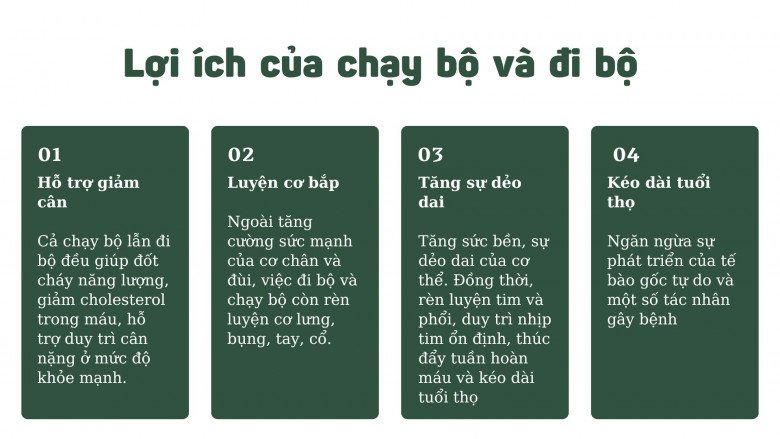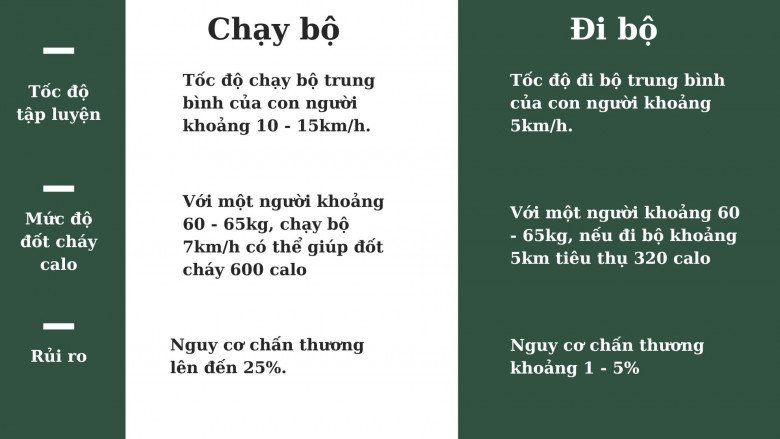
Walking and running are the most popular forms of exercise today, chosen by many people. Both activities offer health benefits and are suitable for everyone. However, running and walking are fundamentally different, depending on the purpose and needs. Have you ever wondered which one is right for you? Let’s look at some comparisons below to see which is the best choice!

A study at a university in the United States was conducted over six years to find the answer to which is better for weight loss. The study involved nearly 50,000 people, including about 33,000 runners and 15,000 walkers. The research showed that both forms of exercise bring many health benefits.

Both running and walking offer numerous health and fitness benefits.
Comparing Running and Walking
Although they are very good for health and help with weight loss, walking and running have many differences. Specifically, they differ in the number of calories burned and the intensity of the workout.

A brief comparison of some features of running and walking.
As seen in the comparison table, running burns more calories in the same amount of time. Walking focuses on endurance and flexibility, while running prioritizes calorie burning. “The biggest difference between running and walking is the number of calories burned. It’s not calories/km, but calories/minute,” said Paul D. Thompson, chief of cardiology at Hartford Hospital in the United States.
However, because the intensity of running is higher than walking, this also brings a higher risk of injury. So, if you’re wondering which is better, it will depend on your exercise goals.

Walking
If your goal is not to lose weight but to maintain your current figure and stay active, walking is a suitable exercise. Walking at a moderate pace helps tone the body without expending too much energy. A study has shown that regular walking is highly effective in preventing peripheral arterial disease. On the other hand, it also reduces the risk of catching a cold by up to 25% compared to those who don’t walk regularly.
To achieve cardiovascular benefits from walking, you need to walk faster than 5 km/h. Some people can even walk up to 10 km/h! At this brisk walking pace, you still burn the same amount of calories as running but with a lower risk of injury.

– Walk in a group
Walking with friends or family can make this activity more enjoyable and effective. It can also help you stick to your exercise routine.
– Swing your arms when walking
Bend your arms at a 90-degree angle and swing them naturally as you walk. This will encourage you to walk faster and work out your upper body. Additionally, you will burn 5-10% more calories if you swing your arms correctly.
– Try walking uphill
The main difference between walking and running is the number of calories burned. But if you can’t run, how can you increase your energy expenditure? The answer is to walk uphill. If you’re using a treadmill, increase the incline to 5% or 10%. If you’re walking outdoors, look for hills or even a steep road to make your walk more challenging.
– Walk faster
Walking at a faster pace will increase your heart rate and improve your calorie-burning ability compared to a leisurely walk. Many studies have shown that brisk walking can burn as many calories as running.
Running
According to experts, running requires more excessive movements. You have to lift your legs higher and swing your arms harder. All these factors cause the body to burn more calories than walking in a shorter time. Because running burns more calories, those who want to lose weight quickly tend to take up running. It is estimated that running burns twice as many calories as walking.
In addition, running also helps improve health better. This form of exercise increases endurance and improves the body’s ability to regulate temperature better than walking. Those who run regularly will be able to engage in physical activity for longer periods, and their endurance will also be better than those who only walk.
What’s more, it may sound counterintuitive, but running reduces the risk of joint degeneration. A study on runners and walkers found that those who ran regularly had a lower risk of joint degeneration and hip replacement than those who only walked.

This may be because runners tend to have a lower body mass index (BMI) than walkers, resulting in less pressure on the joints and a lower risk of joint-related diseases.
However, compared to walking, running has a higher risk of injury, especially if you haven’t exercised in a long time, are overweight, or have joint pain or diseases. The reason is that many people run with incorrect form, which can lead to falls, fractures, and increased pressure on the joints in the feet and knees.
Therefore, to ensure safety and maximize the benefits of running, keep the following in mind:

– Warm up before exercising
Before running or walking, it is essential to stretch the muscles by rotating the wrists, ankles, shoulders, twisting the torso, and doing squats for 5-10 minutes. This will help prevent injuries during your workout.
– Create a reasonable exercise schedule
You should set a scientific and suitable schedule for walking and running, considering your work and personal time. Make sure to allow your body to rest and recover. For example, you can walk or run on even or odd days. Avoid exercising too early or too late in the day.
– Choose a suitable location
For walking and running, you can exercise outdoors in parks, beaches, fields, or residential areas. Alternatively, you can work out safely at home on a treadmill.
– Choose the right shoes
Wearing the wrong size shoes, worn-out shoes, or inappropriate shoes for running can cause injuries during your workout.
– Exercise intensity
Beginners often think that the more they run, the better the results. This misconception can lead to injuries such as sprains and dislocations.
When starting to run, maintain a consistent and moderate pace to allow your body to adapt to the exercise intensity and avoid overexertion. If you experience any pain, reduce the duration and speed or stop. Experts recommend taking two days off each week to allow your muscles to relax and recharge.
Running, Trail Running, and Trekking? Which is Best for Women?’>What’s the Difference Between Running, Trail Running, and Trekking? Which is Best for Women?
Surely you’ve heard of various forms of running, such as running, hiking, trekking, and trail running. But do you know the differences between these disciplines and which one is the best fit for you? Let’s explore the unique characteristics of each and find the perfect match for your fitness journey!
Is Eating Salad at Night or in the Morning Better for Weight Loss? An Answer That Leaves Many Reflecting.
“In today’s fast-paced world, salads have become a go-to option for those seeking a quick, convenient, and nutritious meal to maintain their health and figure. However, consuming salads at the wrong time can lead to digestive issues and even weight gain. It’s important to understand the best times to enjoy a salad to ensure you’re getting the most out of this healthy choice.”








































